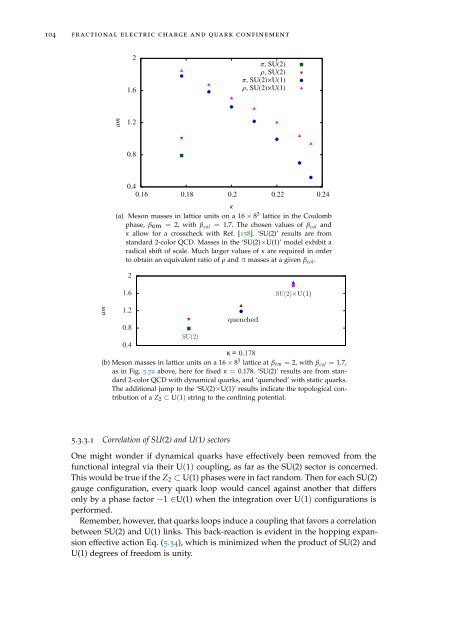Topology, symmetry, and phase transitions in lattice gauge ... - tuprints
Topology, symmetry, and phase transitions in lattice gauge ... - tuprints
Topology, symmetry, and phase transitions in lattice gauge ... - tuprints
Create successful ePaper yourself
Turn your PDF publications into a flip-book with our unique Google optimized e-Paper software.
104 fractional electric charge <strong>and</strong> quark conf<strong>in</strong>ement<br />
2<br />
1.6<br />
π, SU(2)<br />
ρ, SU(2)<br />
π, SU(2)×U(1)<br />
ρ, SU(2)×U(1)<br />
am<br />
1.2<br />
0.8<br />
0.4<br />
0.16 0.18 0.2 0.22 0.24<br />
κ<br />
(a) Meson masses <strong>in</strong> <strong>lattice</strong> units on a 16 × 8 3 <strong>lattice</strong> <strong>in</strong> the Coulomb<br />
<strong>phase</strong>, βem = 2, with β col = 1.7. The chosen values of β col <strong>and</strong><br />
κ allow for a crosscheck with Ref. [158]. ‘SU(2)’ results are from<br />
st<strong>and</strong>ard 2-color QCD. Masses <strong>in</strong> the ‘SU(2)×U(1)’ model exhibit a<br />
radical shift of scale. Much larger values of κ are required <strong>in</strong> order<br />
to obta<strong>in</strong> an equivalent ratio of ρ <strong>and</strong> π masses at a given β col .<br />
2<br />
1.6<br />
am<br />
1.2<br />
0.8<br />
0.4<br />
κ = 0.178<br />
(b) Meson masses <strong>in</strong> <strong>lattice</strong> units on a 16 × 8 3 <strong>lattice</strong> at β em = 2, with β col = 1.7,<br />
as <strong>in</strong> Fig. 5.7a above, here for fixed κ = 0.178. ‘SU(2)’ results are from st<strong>and</strong>ard<br />
2-color QCD with dynamical quarks, <strong>and</strong> ‘quenched’ with static quarks.<br />
The additional jump to the ‘SU(2)×U(1)’ results <strong>in</strong>dicate the topological contribution<br />
of a Z 2 ⊂ U(1) str<strong>in</strong>g to the conf<strong>in</strong><strong>in</strong>g potential.<br />
5.3.3.1 Correlation of SU(2) <strong>and</strong> U(1) sectors<br />
One might wonder if dynamical quarks have effectively been removed from the<br />
functional <strong>in</strong>tegral via their U(1) coupl<strong>in</strong>g, as far as the SU(2) sector is concerned.<br />
This would be true if the Z 2 ⊂ U(1) <strong>phase</strong>s were <strong>in</strong> fact r<strong>and</strong>om. Then for each SU(2)<br />
<strong>gauge</strong> configuration, every quark loop would cancel aga<strong>in</strong>st another that differs<br />
only by a <strong>phase</strong> factor −1 ∈U(1) when the <strong>in</strong>tegration over U(1) configurations is<br />
performed.<br />
Remember, however, that quarks loops <strong>in</strong>duce a coupl<strong>in</strong>g that favors a correlation<br />
between SU(2) <strong>and</strong> U(1) l<strong>in</strong>ks. This back-reaction is evident <strong>in</strong> the hopp<strong>in</strong>g expansion<br />
effective action Eq. (5.34), which is m<strong>in</strong>imized when the product of SU(2) <strong>and</strong><br />
U(1) degrees of freedom is unity.
















